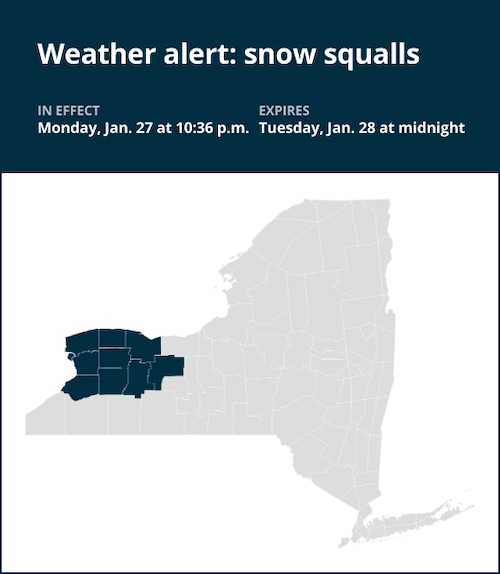At 10:36 p.m. on Monday, the National Weather Service issued a weather notice for Niagara, Orleans, Monroe, Erie, Genesee, Wyoming, Livingston, and Ontario counties, warning of snow squalls through Tuesday at midnight.
“In Western New York, snow is beginning to fall. When paired with strong gusts that can reach 60 mph, the snow will cause regions of blowing and drifting snow, which can occasionally reduce visibility below a half mile. Overnight travel will be extremely challenging due to the snow and blowing snow, particularly in open places where snow tends to drift more, the weather agency said.
West Seneca, North Tonawanda, Buffalo, Rochester, Greece, Cheektowaga, Irondequoit, Niagara Falls, West Seneca, Chili, Lockport, Lackawanna, Batavia, Kenmore, Depew, Amherst, Tonawanda, Lancaster, Hamburg, and Brockport are among the places affected by the alert. The following highways are included in this: Between exits 5 and 12, Interstate 390. Between exits 46 and 57A on Interstate 90. In winter weather conditions might quickly deteriorate. Steer clear of pointless travel. If you must travel, slow down, give yourself more time, and be ready for bad visibility.
Navigating snow squalls: Understanding, preparing, and staying safe
What are snow squalls?
Strong cold fronts are frequently linked to snow squalls, which are severe winter weather conditions. Even in the absence of a significant winter storm, they can swiftly cover roads with snow and ice. Even while these squalls usually last less than an hour and only produce light snow accumulation, their restricted visibility, strong winds, and quickly falling temperatures can make them dangerous. Unfortunately, in the past, these circumstances have played a role in catastrophic and occasionally fatal road accidents.
What is the difference between a snow squall and a snowstorm?
A snowstorm and a snow squall differ primarily in their strength and length. Usually lasting 30 to 60 minutes, snow squalls are short yet fierce. A snowstorm, on the other hand, can last for several hours or even days.
Snow squall warnings
Like warnings for tornadoes or severe thunderstorms, snow squalls are quickly issued for specific locations. They provide vital, locally relevant information that can save lives. If there is a snow squall warning in your location, it is recommended to wait until the squall passes before driving.
Actions to take
When a snow squall warning is issued, people should heed the weather service’s instructions, which include the following crucial steps:
Avoid or postpone travel: It is best to wait until the snow squall has gone through your area before driving if a snow squall warning has been issued for your area. During snow squalls, roadways and highways are especially dangerous.
Reduce speed and improve visibility: If you’re already on the road during a snowstorm, put safety first by slowing down. To improve visibility for other vehicles and yourself, turn on your danger lights in addition to your headlights.
Keep a safe distance: Make sure there is enough space between your car and the one in front of you. In order to account for decreased vision and the possibility of unpredictable road conditions during a squall, this precaution is crucial.
Steer clear of quick braking: Sudden braking can cause a vehicle to lose control in icy and slippery conditions. To reduce the chance of sliding or producing a chain reaction crash, it is safer to reduce your speed gradually.
Winter weather safety advice: Go to the weather service’s Winter Weather Safety page for detailed instructions on how to keep safe before, during, and after experiencing winter weather. This website provides helpful advice and safety measures to assist you successfully deal with the difficulties presented by winter weather.
Make sure your car is ready for winter driving by checking the tires, brakes, lights, and making sure all the fluids are at the right levels before you go. A well-maintained car is better equipped to handle the challenges of winter driving.
Essentials for an emergency kit: Always keep a fully stocked emergency bag in your car with essentials like water, non-perishable food, blankets, a flashlight, and a first aid kit. For better tire traction, add jumper cables, flares or a reflective triangle, ice scraper, a map, a car cell phone charger, and cat litter or sand. Should you experience an emergency or unplanned breakdown while traveling, these supplies can be quite helpful.
In conclusion, putting one’s own safety first and following the weather service’s advice can greatly reduce dangers when a snow squall warning is in effect. People can travel through these winter dangers with more assurance and security if they are aware of them, plan beforehand, and remain alert.
United Robots offers a service called Advance Local Weather Alerts that gathers the most recent information from the National Weather Service using machine learning.






+ There are no comments
Add yours